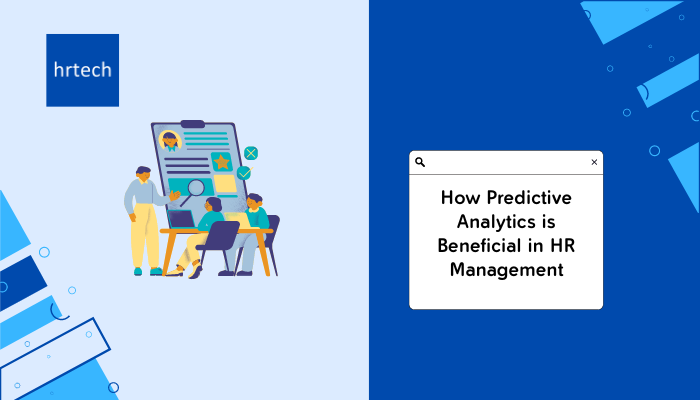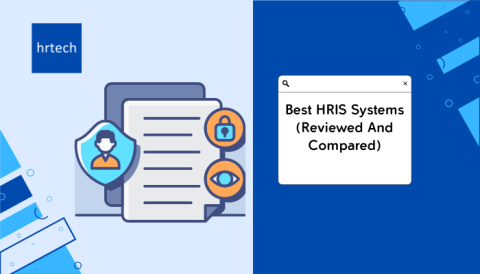Imagine being able to predict employee turnover, spot the next top performer, or make your hiring process faster all with just a few clicks. It might sound like science fiction, but predictive analytics in HR is making this a reality for companies around the world. By looking at past data and current workforce trends, HR teams can now make smarter, data-driven decisions.
This not only makes HR processes more efficient but also leads to a more engaged and productive workforce. Let’s look at why predictive analytics is such a game-changer for HR management.
What Is Predictive HR Analytics?
Predictive HR analytics uses data analysis and modeling to predict future outcomes and guide HR decisions. It looks at past and current data to find patterns that help companies understand employee behavior, improve talent management, and boost productivity.
A report by Grand View Research shows that the HR analytics market is expected to grow a lot, reaching around $3.28 billion by 2030, with an annual growth rate of over 14.8% from 2023 to 2030. This shows strong investment in HR technologies that support effective workforce management.
How Does Predictive HR Analytics Differ From Descriptive HR Analytics?
Predictive HR analytics is about using past data to predict future trends and outcomes. It uses advanced statistics and machine learning to make these forecasts. On the other hand, descriptive HR analytics looks at past data to explain what has already happened. This helps organizations understand their past performance and make better decisions. While predictive analytics focuses on what might happen in the future, descriptive analytics explains what happened in the past.
| Aspect | Predictive HR Analytics | Descriptive HR Analytics |
| Definition | Uses historical data and statistical algorithms to forecast future HR trends and outcomes. | Analyzes past data to understand what has happened in HR processes. |
| Purpose | To predict future events, trends, or behaviors in the workforce. | To provide insights into historical data and performance metrics. |
| Data Utilization | Utilizes advanced techniques such as machine learning and predictive modeling. | Relies on historical data analysis and reporting tools. |
| Decision-Making | Supports proactive decision-making by anticipating future needs and challenges. | Aids in understanding past performance to inform current decisions. |
| Examples of Use | Predicting employee turnover, identifying potential high performers, forecasting training needs. | Reporting on employee satisfaction, analyzing recruitment effectiveness, reviewing past hiring trends. |
| Complex | More complex due to the use of algorithms and predictive models. | Generally less complex; focuses on straightforward data analysis. |
| Outcome | Focus Aims to influence future outcomes and improve strategic planning. | Aims to provide clarity on past performance and operational efficiency. |
Benefits and applications of Predictive analytics in HR management
Predictive analytics in human resources (HR) is a useful tool that uses HR data analysis to improve workforce management. By looking at past and current data, companies can make better decisions to improve hiring, keep employees longer, manage talent more effectively, boost productivity, cut costs, predict workforce trends accurately, and support diversity and inclusion efforts. Here is a closer look at how these applications work and their benefits—similar to how predictive marketing uses customer behavior data to optimize marketing strategies. Both disciplines leverage advanced analytics to enhance outcomes and anticipate future needs.
Better Hiring Decisions
Predictive analytics improves hiring by analyzing past data to find the qualities of successful employees. For example, companies can use algorithms to compare candidate profiles with past performance management data to predict who will do well in specific roles.
A study by the Society for Human Resource Management (SHRM) showed that companies using predictive analytics in hiring saw a 20% boost in hiring efficiency. Additionally, predictive models can cut the time spent on unqualified candidates by up to 30%, letting HR teams focus on top applicants.
Improved Employee Retention
Losing employees can be expensive for companies. Predictive analytics helps identify why employees retention by analyzing data from surveys, performance reviews, and even social media. For example, companies like IBM have used these models to look at employee data and cut turnover rates by 25%.
By addressing the problems found through predictive analytics, companies can create targeted strategies to keep employees engaged and loyal.
Optimized Talent Management
Predictive analytics helps improve talent management by predicting future skill needs based on workforce trends and business goals. Companies can use data on employee performance and career paths to spot high-potential employees for leadership roles.
A report from Deloitte shows that companies using predictive analytics for talent management see a 10-15% boost in employee productivity because skills are better matched with the company’s needs.
Increased Workforce Productivity
Using predictive analytics, companies can boost workforce productivity by gaining insights into employee performance and engagement. For example, they can spot patterns showing when employees are most productive or at risk of burnout.
A study by Gallup found that companies with high employee engagement often identified through predictive analytics have 21% higher profits and 17% higher productivity than those with lower engagement.
Cost Reduction
Using predictive analytics can help cut costs in many areas of HR. By reducing turnover and improving hiring processes, companies save money on recruiting and training new employees.
For example, replacing an employee can cost 1.5 to 2 times their yearly salary due to hiring, lost productivity, and training costs. Predictive analytics helps avoid these expenses by supporting smarter hiring and proactive retention strategies.
Accurate Future Workforce Trend Forecasting
Predictive analytics helps HR teams accurately predict future workforce trends. By looking at demographic data, market trends, and internal workforce changes, companies can plan for shifts in labor needs. For example, they can foresee retirements or skill shortages early and plan for replacements or targeted hiring.
This is especially important as industries change; the World Economic Forum estimates that 85 million jobs could be lost by 2025 due to automation and AI.
Salary and Benefits Optimization
Predictive analytics helps companies set the right salaries and benefits. By studying market pay trends and employee satisfaction surveys, companies can create competitive compensation plans that attract and keep top talent while controlling costs. Research shows that companies with good pay strategies can reduce turnover rates by up to 30%.
Streamlined Diversity and Inclusion Analytics
Predictive analytics greatly supports diversity and inclusion efforts. Companies can examine hiring data to spot biases or track how well D&I programs are working over time.
By using predictive models to see how diversity affects team performance, companies can build more inclusive workplaces. Research by McKinsey shows that diverse teams are 35% more likely to outperform their competitors.
Reducing Biases in HR Decision-Making
One of the critical advantages of predictive analytics is its potential to reduce biases in HR decision-making processes. Traditional hiring practices may inadvertently favor certain demographics over others; however, predictive models can help ensure decisions are based on objective data rather than subjective judgments.
This shift not only promotes fairness but also enhances the overall quality of hires.
Real-Life Examples of Predictive Analytics in HR
Here are some real-life examples of how companies use predictive analytics in HR. These include reducing employee turnover, improving hiring processes, boosting employee engagement, and supporting remote work transitions.
1. HP’s Use of Predictive Models to Reduce Turnover

HP used predictive models to tackle employee turnover, which affects both productivity and costs. By analyzing factors like workspace satisfaction, performance, and work environment, they could identify employees at a higher risk of leaving. This data-driven approach helped them create targeted strategies to keep those employees, reducing turnover and keeping a more stable workforce.
2. Google’s Data-Driven Hiring Process

Google improved its hiring process using data analytics. They found that their original process of up to 25 interviews was taking too much time. After analysis, they realized that just four interviews could predict a candidate’s suitability with 86% accuracy. This change allowed Google to reduce the hiring time by 75%, from 180 days to just 47, making their hiring process more efficient.
3. Best Buy’s Link Between Employee Engagement and Revenue

Best Buy used predictive analytics to connect employee engagement with store revenue. By studying data on employee satisfaction, performance, and customer interactions, they discovered that higher employee engagement led to increased revenue. This insight helped them implement strategies to boost engagement, improving their financial results.
4. American Express’s Support for Remote Work

American Express used predictive analytics to manage its shift to remote work. By analyzing employee performance, communication, and engagement levels, they identified who was thriving remotely and who needed extra support. This proactive approach allowed them to fine-tune their remote work strategies, ensuring a smooth transition and keeping productivity high.
Challenges in Using Predictive Analytics in HR Management Software
The challenges in using predictive analytics in HR software are below.
1. Data Privacy Concerns
Working with sensitive employee data raises privacy issues. It’s important to follow data protection laws, like GDPR or CCPA, to keep employee trust and avoid legal problems.
2. Bias in Data & Algorithms
Predictive models can unintentionally reflect existing biases in the data, leading to unfair hiring, biased performance reviews, and unequal treatment. Regular monitoring and adjustments are needed to ensure fairness.
3. Combining Different Data Sources
HR data comes from various sources like recruitment platforms, performance systems, and surveys. Bringing all this data together into one analytics system can be complicated and take a lot of time.
4. Following HR Compliance
Predictive analytics must align with HR compliance and labor laws. Ensuring that these analytics meet legal standards can be a tough task.
5. Skill Gaps in HR Analytics
HR teams might not have the technical skills to use and understand predictive analytics. Closing this gap means investing in training or hiring data experts, which can be costly and require more resources.
Implementing Predictive HR Analytics: A Strategic Approach
The defining strategic business objectives, training HR professionals in data science, fostering collaboration with IT and data specialists, and selecting the right analytics software, organizations can harness the power of data to drive informed decision-making and enhance workforce management.
| Step | Description |
| 1. Defining Strategic Business Objectives | Clearly outline the goals and objectives that predictive HR analytics will support, aligning them with overall business strategy. |
| 2. Training HR Professionals in Data Science | Provide training and resources to HR professionals to enhance their data literacy and analytical skills, enabling them to effectively utilize data-driven insights. |
| 3. Collaboration with IT and Data Specialists | Foster collaboration between HR, IT, and data specialists to ensure seamless integration of analytics tools and access to necessary data. |
| 4. Choosing the Right Analytics Software | Select appropriate analytics software that meets the organization’s needs, considering factors such as user-friendliness, scalability, and integration capabilities. |
Improving HR Strategies with Predictive Analytics
Predictive analytics is important for improving HR strategies because it helps organizations make informed decisions based on data about their employees. By looking at past employee information, HR teams can create specific plans to keep employees from leaving, identify areas where training is needed, and manage risks more effectively. This forward-thinking approach not only makes employees happier but also boosts the overall success of the organization.
| HR Strategy | Description |
| Developing Customized Retention Strategies | Use data to find employees who might leave and create personalized programs to keep them engaged and satisfied. |
| Addressing Skill Gaps Through Training Programs | Look at employee skills to find gaps and create training programs that help workers develop the skills needed for their jobs. |
| Better Risk Management and Proactive HR Initiatives | Use predictive analytics to spot potential HR problems early, allowing the organization to take steps to prevent issues and maintain a stable workforce. |
Conclusion
Predictive analytics is changing HR by allowing data-driven decisions, improving hiring, boosting employee retention, and enhancing overall workforce management. It gives companies valuable insights to address potential challenges and create a more efficient, engaged workplace.
By using data, businesses can make smarter HR decisions that lead to long-term success and a thriving work environment. Now is the perfect time to adopt predictive analytics and elevate your HR strategies to the next level.
We specialize in helping businesses use predictive analytics to transform their HR operations. Our innovative solutions are designed to streamline decision-making, enhance recruitment, and improve employee retention rates.
Get in touch with us to see how our HR management solutions can help you create a thriving workplace environment.
Let’s take your HR management to new heights with our powerful, data-driven solutions.





